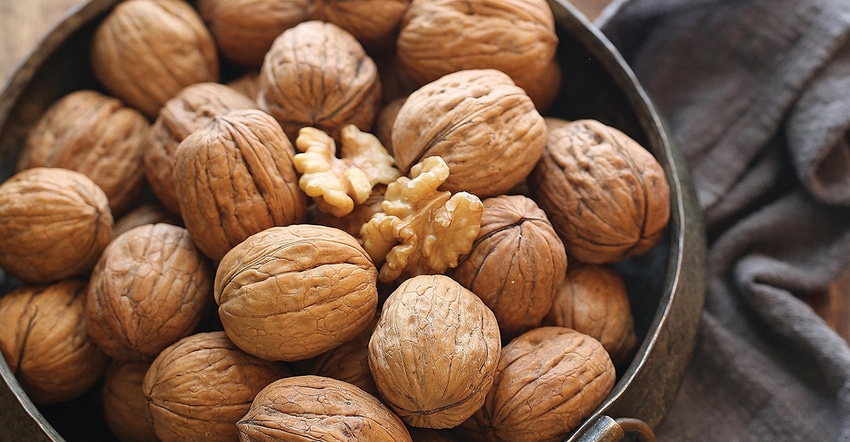
Although bearing acres increased slightly --- about 5,000 acres or 1% --- California 2021 walnut production took a deep dive, down 15% from last year’s record production.
The precipitous drop is blamed on widespread freezes in the late Fall of 2020 that resulted in frost damage to walnut orchards across the state where leaf-out and subsequently reduced nut set were impacted.
In releasing the Sept. 1 Objective Measurement Report, the USDA/NASS Pacific Regional Office noted: “Although chilling hours were up from last year, walnut growers throughout the state struggled with drought conditions and water availability. The average nut set per tree was 992, down 17% from the previous year. In-shell weight per nut was 22.2 grams versus 22 grams the year prior.”
Jennifer Williams represents the California Walnut Board and Commission and said there were few real surprises in the final numbers. “We knew the crop was going to be down although I am somewhat surprised it’s down that much. We were expecting a re-balance following last year’s record numbers. So 670,000 tons is still a good number based on historical records because it wasn’t that long ago that we were harvesting less than half that number.”
So how do walnut growers view the 2021 numbers? Will lesser product volume translate to better prices? “That is definitely a possibility although we would have no idea how much because we’re not involved in the pricing aspect,” she said. “But historically, when the crop is shorter, grower pricing tends to be higher.”
A closer review of the production forecast numbers show that some of the other criteria, like kernel size and in-shell weight, were down from previous yields. Again, not a surprise to the Walnut Board folks. “No reason to use the word ‘disappointed’,” said Williams. “We were expected numbers in the range of those in the report although those numbers were in the lower range of what we were expecting and many of the category numbers did end up on par.”
The report alluded to two events, continuing drought and surprise frost damage in the Fall of 2020, that were believed mainly responsible for the diminished numbers. “There was a huge frost last November and the yield was impacted,” she said. “Mother Nature can be temperamental and unpredictable at times.”
Unexpected cold
That unexpected temperature drop also caught prognosticators at RaboResearch off-guard as their early 2021 Five-Year Walnut Market Outlook had predicted: “While global walnut production and exports will set records during 2020/21, U.S. production is at record levels and will likely remain in check due to a lack of price incentives. While U.S. exports will continue to grow in subsequent marketing seasons, the challenge of boosting domestic demand will continue.”
The category of bearing acreage did rise slightly and now shows 385,000, up some 5,000 from last year’s stats. “We know there’s been a lot of new stuff planted as some of the older acreage got pulled out and new varieties planted,” Williams said.
Walnut orchards are still in favor for the future apparently, according to input from the field. “Based on reports of some almond orchards being rogued and fallowed, I asked that specific question to several growers and what they said was that the almonds being removed had been planted on marginal land and with the drought, it wasn’t worth it anymore. Walnut growers don’t have that issue.”
Williams cited some forward thinking on water issues and conservation, noting a trend toward drip irrigation and a commitment to the long term. “It’s a tree,” she emphasized. “It takes a long time to grow one into commercially viable production, so walnut growers are practicing efficiency with water use and patience for the long term.”
Read more about:
WalnutsAbout the Author(s)
You May Also Like




